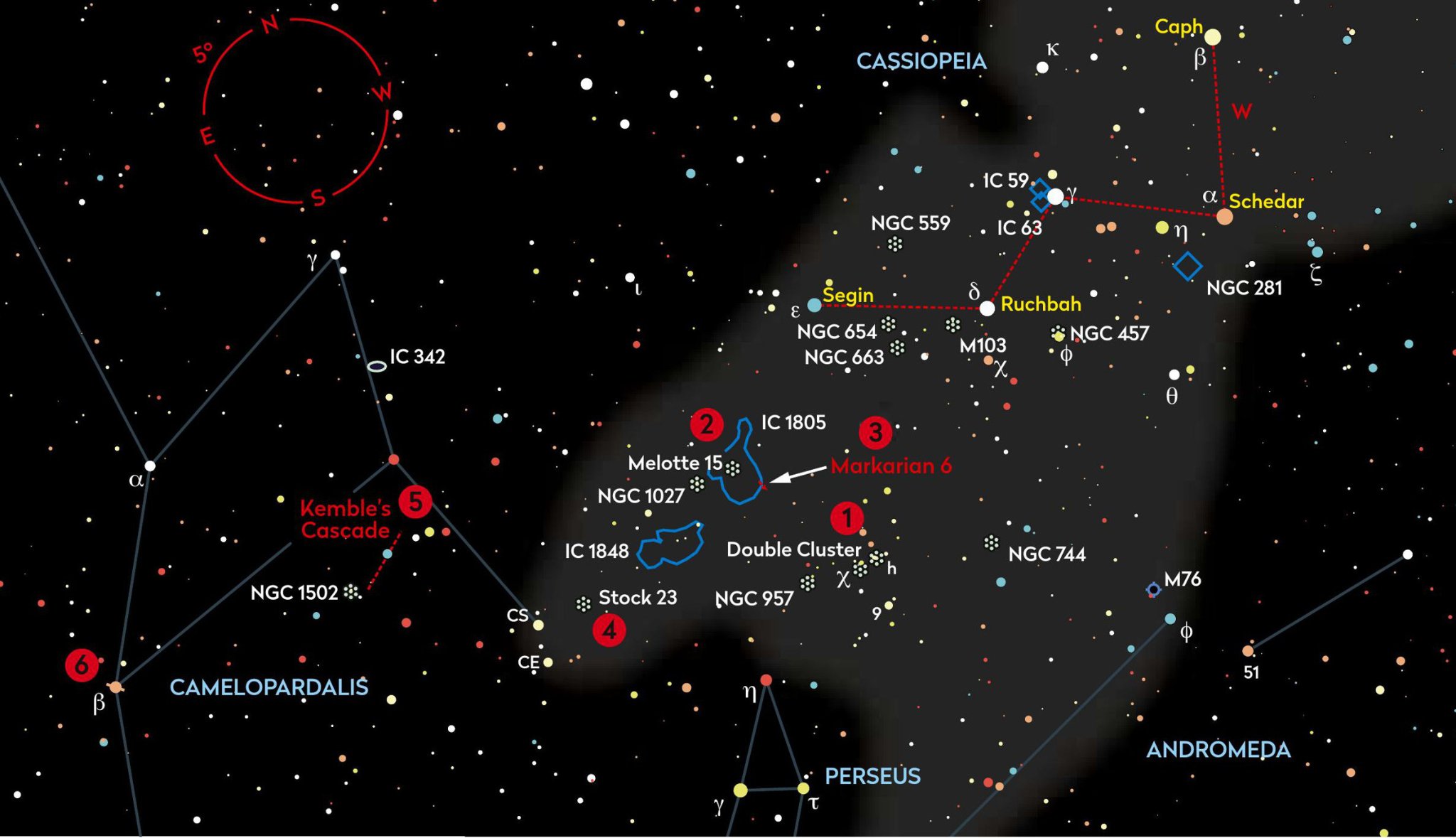This month’s targets include a double act, a cascade and the heart of the Heart

1. The Double Cluster
Recommended equipment: 10×50
Half-way between mag. 2.6 Ruchbah (Delta (d) Cassiopeiae) and mag. +2.9 Gamma (γ) Cassiopeiae you will find a close pair of open clusters. In a rural sky, you can see them with your naked eye as a distinctly elongated smudge of light, but binoculars will reveal two little concentrations of stars. Those stars are intrinsically extremely bright: if the Sun was there, it would be too faint for you to see it in binoculars!
2. Melotte 15
Recommended equipment: 10×50
If you imagine that mag. +3.3 Segin (Epsilon (ε) Cassiopeiae) and mag. +4.6 Iota (ι) Cassiopeiae are two corners of an equilateral triangle, Melotte 15 is the third corner. In 10×50 binoculars, you’ll see a large (20-arcminute) glow with a handful of brighter stars forming a V shape. If you have a UHC filter to hold over an eyepiece, you might see the nebulosity (IC1805, the Heart Nebula) that surrounds, and gave birth to, the cluster.
3. Markarian 6
Recommended equipment: 15×70
Markarian 6 lies slightly less than 1° to the south-southwest of Mel 15. It’s quite easy to miss, so we use larger binoculars. What you should see is an arrow of half a dozen ninth-magnitude stars pointing southwards. Owing to its faintness compared to Mel 15, you might assume it is much further away, but at 1,600 lightyears it is actually just under a quarter of the distance.
4. Pazmino’s Cluster
Recommended equipment: 10×50
If you pan slightly more than 1.5° due west from mag. +4.3 CS Camelopardalis, you will find an unremarkable little trapezium of seventh and eigth-magnitude stars. This is Stock 23, also known as Pazmino’s Cluster. Your binoculars should reveal that this is much more than a trapezium and you may be able to resolve about half a dozen stars against a faintly glowing patch of sky about 10 arcminutes in diameter.
5. Kemble’s Cascade
Recommended equipment: 10×50
On spring evenings, Kemble’s Cascade is near-horizontal in the sky, so this line of eighth-magnitude stars, with a brighter fifth-magnitude one in the middle, looks more like a wristwatch or bracelet opened out against the sky than a tumbling cascade. To find it, extend a line from mag. +2.3 Caph (Beta (β) Cassiopeiae) to Segin the same distance to the central bright star.
6. Beta Cam
Recommended equipment: 10×50
You can see mag. +4.0 Beta (β) Camelopardalis with the naked eye, and its mag. +7.4 companion, which lies 84 arcseconds southwest is easy to distinguish, even in small binoculars. Beta Cam is a yellow supergiant in transition between being a hot new blue star and a much cooler red supergiant. It sometimes flashes, probably due to the equivalent of huge solar flares.
MORE ONLINE
Print out the Binocular Tour chart
www.skyatnightmagazine.com/bonus-content/9BN84GZ